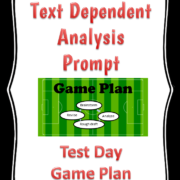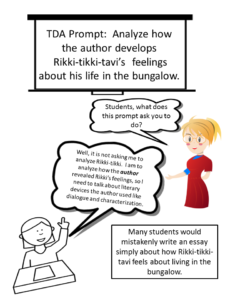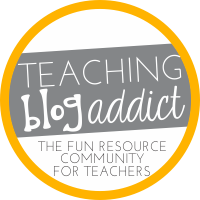Text Dependent Analysis Prompt for Our Writing Test
I teach in South Carolina, and this is our first year having a text dependent analysis prompt for our writing test. There are so many steps in teaching twelve and thirteen year old students to successfully accomplish this type of writing.
Scroll down to see our “GAME PLAN” for the test day!
One of the main steps in preparing students for a text dependent analysis prompt for our writing test is to teach them the difference between analyzing and simply summarizing. I do this early on with the help of pictures. For example, I place a picture of a family on the screen. I then ask students to tell me what they see. They respond by saying things like, “There are three children.” “The house is a mess.” “The father has a mess on the counter and flour on his face, and the mother is dressed up”. I then tell them to analyze the picture. What I am looking for is an answer like the following: “I think the traditional roles are reversed in this household. It looks like the mother is going to work, and the father is a stay at home dad. It also looks like the dad is struggling a little with the cooking and cleaning.” I then ask this student to support his/her statement. She does so by pointing out ways in which the picture proves what she is saying. This is the easiest way to show what analysis is and what it is not. Analyzing is not simply pointing out what is there. Instead it is digging in deeper to discover something and then looking to the text to support whatever you think or believe.
Of course, this is only one small step in preparing students for a text dependent analysis prompt for our writing test. We have a tremendous amount of other things to cover too, including simple things like how to write an introduction. Students must know how to write a topic sentence, for example, which is a huge feat within itself!
I did want to share our “game plan” that we go over before the day of the test. We expect all of our students to follow these steps on the day of the test. Before they even attempt to write, they first must analyze the prompt! Below is our detailed game plan.
You can also print this text dependent analysis for our writing test game plan by clicking here!
Game Plan
- Before reading the text, find the text dependent analysis writing prompt. That way you will have in mind what you will have to write about before you read!
- Read the prompt three times – YES 3 Times!!
- Underline what it is asking you to do.
- Pull out key words from the prompt, and think about it. Make sure you are not missing anything! What exactly are they telling you to do? Spend time analyzing the prompt!
- Write your topic sentence – the one for your entire paper. Remember, use words from the prompt to write it.
- Now, go back and read the text. It may be an article, a story, a poem, or two different things to read. Annotate the text as you go – keeping in mind what you will have to write about.
- Before writing, read your prompt again.
- Stop and think for a few minutes. How many paragraphs will you need? How will you do what they are asking you to do? Go back and look over the text thinking about what you must do.
- Brainstorm!!! Use scratch paper to get your ideas out. Write what the prompt is asking you to do at the top of your scratch paper. You will need to continuously look at it to make sure you are writing about what you are supposed to write about! You can do a bubble map, a T chart, a list, or whatever helps you to get your thoughts out on paper.
- Plan out your paragraphs with topic sentences for each and bullets for your main points. (Now you are organizing – introduction, body, conclusion)
- Go find evidence that you can use BEFORE you write – circle it or highlight it. You may want to write these quotes from the text on your scratch paper. Remember, you MUST cite evidence to prove what you are saying.
- Write a rough draft. For the LOVE of your English teacher, make sure you CITE TEXTUAL EVIDENCE!!!!!!!! Also, make sure you stick to your topic sentence and explain yourself. Don’t forget to hammer the topic sentence home in the last sentence of each paragraph.
- Revise your rough draft – Work on your word choice and make sure your essay makes sense. Do you need to add more evidence? Did you “Hammer home” the topic sentence by the end of each paragraph? Can you make your introduction better? Can you improve your conclusion?
- Edit your rough draft –Does it fit? If not, what can you take out? Did you capitalize the beginning of every sentence? Look for grammar gremlins (its, it’s, etc.) Do you have the correct punctuation at the ends of your sentences? Do you have commas where needed? Check your spelling.
- Write your final draft in the text booklet. Take your time, and write as neatly as you can. Make sure you indent.
- Read over your final draft and make neat changes.
I wish you and your students the best of luck! 🙂
Shannon





